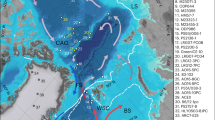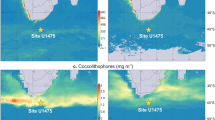Abstract
The modern Arctic Ocean is regarded as a barometer of global change and amplifier of global warming1 and therefore records of past Arctic change are critical for palaeoclimate reconstruction. Little is known of the state of the Arctic Ocean in the greenhouse period of the Late Cretaceous epoch (65–99 million years ago), yet records from such times may yield important clues to Arctic Ocean behaviour in near-future warmer climates. Here we present a seasonally resolved Cretaceous sedimentary record from the Alpha ridge of the Arctic Ocean. This palaeo-sediment trap provides new insight into the workings of the Cretaceous marine biological carbon pump. Seasonal primary production was dominated by diatom algae but was not related to upwelling as was previously hypothesized2. Rather, production occurred within a stratified water column, involving specially adapted species in blooms resembling those of the modern North Pacific subtropical gyre3, or those indicated for the Mediterranean sapropels4. With increased CO2 levels and warming currently driving increased stratification in the global ocean5, this style of production that is adapted to stratification may become more widespread. Our evidence for seasonal diatom production and flux testify to an ice-free summer, but thin accumulations of terrigenous sediment within the diatom ooze are consistent with the presence of intermittent sea ice in the winter, supporting a wide body of evidence for low temperatures in the Late Cretaceous Arctic Ocean6,7,8, rather than recent suggestions of a 15 °C mean annual temperature at this time9.
This is a preview of subscription content, access via your institution
Access options
Subscribe to this journal
Receive 51 print issues and online access
$199.00 per year
only $3.90 per issue
Buy this article
- Purchase on Springer Link
- Instant access to full article PDF
Prices may be subject to local taxes which are calculated during checkout




Similar content being viewed by others
References
Graversen, R. G., Mauritsen, T., Tjernstrom, M., Kallen, E. & Svensson, G. Vertical structure of recent Arctic warming. Nature 451, 53–56 (2008)
Kitchell, J. A. & Clark, D. L. Late Cretaceous-Paleogene paleogeography and paleocirculation: evidence of north polar upwelling. Palaeogeogr. Palaeoclimatol. Palaeoecol. 40, 135–165 (1982)
Dore, J. E., Letelier, R. M., Church, M. J., Lukas, R. & Karl, D. M. Summer phytoplankton blooms in the oligotrophic North Pacific Subtropical Gyre: historical perspective and recent observations. Prog. Oceanogr. 76, 2–38 (2008)
Kemp, A. E. S., Pearce, R. B., Koizumi, I., Pike, J. & Rance, S. J. The role of mat-forming diatoms in the formation of Mediterranean sapropels. Nature 398, 57–61 (1999)
Sarmiento, J. L., Hughes, T. M. C., Stouffer, R. J. & Manabe, S. Simulated response of the ocean carbon cycle to anthropogenic climate warming. Nature 393, 245–249 (1998)
Falcon-Lang, H. J., MacRae, R. A. & Csank, A. Z. Palaeoecology of late Cretaceous polar vegetation preserved in the Hansen Point volcanics, NW Ellesmere Island, Canada. Palaeogeogr. Palaeoclimatol. Palaeoecol. 212, 45–64 (2004)
Amiot, R. et al. Latitudinal temperature gradient during the Cretaceous Upper Campanian–Middle Maastrichtian: δ18O record of continental vertebrates. Earth Planet. Sci. Lett. 226, 255–272 (2004)
Otto-Bliesner, B. L., Brady, E. C. & Shields, C. Late Cretaceous ocean: coupled simulations with the National Center for Atmospheric Research Climate System Model. J. Geophys. Res. 107 10.1029/2001JD000821 (2002)
Jenkyns, H. C., Forster, A., Schouten, S. & Damste, J. S. S. High temperatures in the Late Cretaceous Arctic Ocean. Nature 432, 888–892 (2004)
Moran, K. et al. The Cenozoic palaeoenvironment of the Arctic Ocean. Nature 441, 601–605 (2006)
Mudie, P. J., Stoffyn-Egli, P. & Van Wagoner, N. A. Geological constraints for tectonic models of the Alpha Ridge. J. Geodynam. 6, 215–236 (1986)
Stoffyn-Egli, P. Iron and manganese micro-precipitates within a Cretaceous biosiliceous ooze from the Arctic Ocean: possible hydrothermal source. Geo-Mar. Lett. 7, 223–231 (1987)
Sarthou, G., Timmermans, K. R., Blain, S. & Treguer, P. Growth physiology and fate of diatoms in the ocean: a review. J. Sea Res. 53, 25–42 (2005)
Kemp, A. E. S., Pike, J., Pearce, R. B. & Lange, C. B. The “Fall dump”—a new perspective on the role of a “shade flora” in the annual cycle of diatom production and export flux. Deep-Sea Res. II 47, 2129–2154 (2000)
Harwood, D. M., Nikolaev, V. A. & Winter, D. M. in Pond Scum to Carbon Sink: Geological and Environmental Applications of the Diatoms (ed. Starratt, S.) 33–59 (Paleontological Society, 2007)
Wagner, T., Damste, J. S. S., Hofmann, P. & Beckmann, B. Euxinia and primary production in Late Cretaceous eastern equatorial Atlantic surface waters fostered orbitally driven formation of marine black shales. Paleoceanography 19 10.1029/2003PA000898 (2004)
Tapia, P. M. & Harwood, D. M. Upper Cretaceous diatom biostratigraphy of the Arctic archipelago and northern continental margin, Canada. Micropaleontology 48, 303–342 (2002)
Dell'Agnese, D. J. & Clark, D. L. Siliceous microfossils from the warm Late Cretaceous and Early Cenozoic Arctic Ocean. J. Paleontol. 68, 31–47 (1994)
Hay, W. W. et al. in Evolution of the Cretaceous Ocean-Climate System (eds Barrera, E. & Johnson, C. C.) 1–47 (Geological Society of America Special Paper 332, 1999)
McQuoid, M. R. & Hobson, L. A. Importance of resting stages in diatom seasonal succession. J. Phycol. 31, 44–50 (1995)
Sachs, J. P. & Repeta, D. J. Oligotrophy and nitrogen fixation during eastern Mediterranean sapropel events. Science 286, 2485–2488 (1999)
Singler, H. R. & Villareal, T. A. Nitrogen inputs into the euphotic zone by vertically migrating Rhizosolenia mats. J. Plankton Res. 27, 545–556 (2005)
Chin, K. et al. Life in a temperate polar sea: a unique taphonomic window on the structure of a Late Cretaceous Arctic marine ecosystem. Proc. R. Soc. B 275, 2675–2685 (2008)
Scharek, R., Tupas, L. M. & Karl, D. M. Diatom fluxes to the deep sea in the oligotrophic North Pacific gyre at Station ALOHA. Mar. Ecol. Prog. Ser. 182, 55–67 (1999)
Harwood, D. M. & Nikolaev, V. A. in Siliceous Microfossils (eds Blome, C. D. et al.) 81–106 (Paleontological Society, 1995)
Kuypers, M. M. M., van Breugel, Y., Schouten, S., Erba, E. & Damste, J. S. S. N2-fixing cyanobacteria supplied nutrient N for Cretaceous oceanic anoxic events. Geology 32, 853–856 (2004)
Kempema, E. W., Reimnitz, E. & Barnes, P. W. Sea ice sediment entrainment and rafting in the Arctic. J. Sedim. Petrol. 59, 308–317 (1989)
Smedsrud, L. H. Frazil-ice entrainment of sediment: large-tank laboratory experiments. J. Glaciol. 47, 461–471 (2001)
Sluijs, A. et al. Subtropical Arctic ocean temperatures during the Palaeocene/Eocene thermal maximum. Nature 441, 610–613 (2006)
Kemp, A. E. S., Dean, J., Pearce, R. B. & Pike, J. in Tracking Environmental Change Using Lake Sediments Vol. 2 Physical and Geochemical Methods (eds Last, W. M. & Smol, J. P.) 7–22 (Kluwer, 2001)
Francus, P., Keimig, F. & Besonen, M. An algorithm to aid varve counting and measurement from thin-sections. J. Paleolimnol. 28, 283–286 (2002)
Scherer, R. P. A new method for the determination of absolute abundance of diatoms and other silt-sized sedimentary particles. J. Paleolimnol. 12, 171–179 (1995)
Bodén, P. Reproducibility in the random settling method for quantitative diatom analysis. Micropalaeontology 37, 313–319 (1991)
Acknowledgements
The research was supported by the award of a NERC Research Studentship (A.D.) and a NERC Research Grant (A.E.S.K. and J.P.). We are grateful to P. Mudie for facilitating sampling of the CESAR-6 core and to D. Clark for providing samples from core FL-437. We thank R. Pearce for assistance with electron microscopy and K. Davis for expertise in drafting. We also thank P. Wilson and H. Pälike for comments on the manuscript.
Author Contributions Preliminary SEM and diatom studies of the material were undertaken by J.P. and A.E.S.K. Detailed SEM lamina studies and diatom analysis were performed by A.D. during PhD studies supervised by A.E.S.K. and J.P. All authors contributed to interpretation. The manuscript was written by A.E.S.K. and incorporates comments from all others.
Author information
Authors and Affiliations
Corresponding author
Supplementary information
Supplementary Information
This file contains Supplementary Notes and Data, Supplementary References, Supplementary Tables S1-S4 and Supplementary Figures S1-S2 with Legends. Supplementary Figure 1 was corrected on 16 July, 2009. (PDF 1256 kb)
Rights and permissions
About this article
Cite this article
Davies, A., Kemp, A. & Pike, J. Late Cretaceous seasonal ocean variability from the Arctic. Nature 460, 254–258 (2009). https://doi.org/10.1038/nature08141
Received:
Accepted:
Issue Date:
DOI: https://doi.org/10.1038/nature08141
This article is cited by
-
Decadal–centennial-scale solar-linked climate variations and millennial-scale internal oscillations during the Early Cretaceous
Scientific Reports (2022)
-
Palaeogeographic regulation of glacial events during the Cretaceous supergreenhouse
Nature Communications (2016)
-
Exploring the long-term Cenozoic Arctic Ocean climate history: a challenge within the International Ocean Discovery Program (IODP)
arktos (2015)
-
4D Arctic: A Glimpse into the Structure and Evolution of the Arctic in the Light of New Geophysical Maps, Plate Tectonics and Tomographic Models
Surveys in Geophysics (2014)
-
Trend of Santonian (Late Cretaceous) atmospheric CO2 and global mean land surface temperature: Evidence from plant fossils
Science China Earth Sciences (2011)
Comments
By submitting a comment you agree to abide by our Terms and Community Guidelines. If you find something abusive or that does not comply with our terms or guidelines please flag it as inappropriate.



